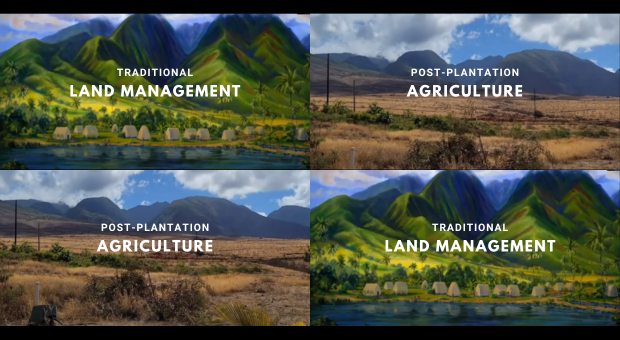17
Aug
[REFLECTION] The Lies about Maui’s Largest Wildfires: There is Nothing “Natural” about the Disaster on Maui and the Flames Fueled by Biodiversity Collapse, Climate Change, and Colonization

(Beyond Pesticides, August 17, 2023) Governor Josh Green of Hawai’i declares the recent Maui wildfires as the largest natural disaster in the state’s history, yet advocates say the tragedy is anything but “natural.” As of Wednesday, the death toll has risen to over 100 lives lost and more than 2,200 structures in Lāhainā — the original capital of the Hawaiian Kingdom have burned to ash. With so much loss, many people are asking who is responsible and how another disaster can be prevented.
The answer to who is to blame is not simple. The initial reports of the fire repeated a trope that Lāhainā is a dry area on Maui and is prone to wildfire, yet in recent days, the news stories have shifted to reveal the area’s ecological history as a wetland. Lāhainā was historically known for its aquatic landscape, with common images of boats around Waiola Church, and the Hawaiian fish pond systems.
People in Hawai’i lament Lahaina’s devastation, mourning the loss of its Native Hawaiian history and culture, while also bracing for the lasting impact this tragedy might have on their communities. Kaniela Ing, the national director of the Green New Deal Network, shared his perspective in a recent interview. Mr. Ing emphasizes the historical significance of Lāhainā before colonization, the overthrow of the Hawaiian government by the U.S., and statehood, portraying it as a cultural heartland brimming with indigenous and ecological wisdom that stretches beyond Hawai’i’s borders.
In this fleeting moment where the world’s eyes are focused on Maui, and it is important to underscore the legacy of Maui’s colonial past. In the 18th century, the sugar barons diverted water to irrigate their seized lands. At the same time, colonists introduced invasive grasses, which now blanket 26 percent of Hawai’i’s expanse, serving as explosive fuel for wildfires.
The history of these colonial powers reverberates to the present day. Mr. Ing underscores that descendants of those barons, families like Alexander and Baldwin who descended from the original oligarchs and began the development of vast sugarcane plantations, are the prominent landowners on Maui, furthering a cycle of power and influence.
The legacy of colonization’s diversion of water, coupled with the climate crisis and biodiversity collapse has led to a less resilient ecosystem. As conversations shift toward reconstruction, community members who demonstrate a long-term mindset are seeking to form the leadership for a sustainable future while valuing the Hawai’ian traditions. Beyond Pesticides organizer and one of the founders of the Maui Food Hub, Autumn Ness, says “This is going to be a really long road of need, and the folks that have been displaced are going to need support, especially with shelter in the long term.” (Check out a recent update via Instagram here).
Kaipo Kekona, indigenous farmer on Maui and president of the Lāhainā Chapter of the Hawai’i Farmers Union United (HFUU), spoke at Beyond Pesticides 2022 National Forum, exemplifies a future that is routed in traditional agriculture. Mr. Kekona is working in Hawai’i to regenerate and sustain traditional farming production on former sugarcane land. He manages a 12.5 acre-farm site for the Ku’ia Agricultural Education Center in the ahupua’a of Ku’ia on Legacy Lands of Keli’i Kulani (foothills of the West Maui Mountains). Critical to the mission for the site is to not only reclaim space as a native historical food property, but also introduce to the community the practices that encourage a healthier food system and the soil health that forms the foundation of productive land management. Mr. Kepona brings the teachings from indigenous practices that have proven to be resilient, healthy, and respectful of life. He serves as the educational coordinator and project director at the Center. This is a critical time to listen to Mr. Kekona for a vision of a future Maui that nurtures resilience to meet the social, economic, and environmental needs of Hawaiians. Please view Mr. Kekona’s talk on critical issues facing Maui.
The importance of ongoing support for disaster survivors, extending beyond the immediate aftermath, cannot be overstated. The Maui wildfires, touted as Hawai’i’s worst “natural” disaster, reveal connections between historical threads of colonization, climate change, biodiversity loss, and current challenges, urging a united effort to not only rebuild but also reclaim the agency of the affected communities. Click here to support the Maui Food Hub.
HFUU’s Maui Response Fund has been established to support our immediate emergency relief, market restoration, mental health support, and land access initiatives. Maui’s resilience is unwavering, but the need for support is paramount. See HFUU’s Resources for Affected Farmers.
Please donate here, “Maui Response Fund” in the note section, to help us support Maui’s ʻOhana.
All unattributed positions and opinions in this piece are those of Beyond Pesticides.
Source: Lahaina used to be a wetland











